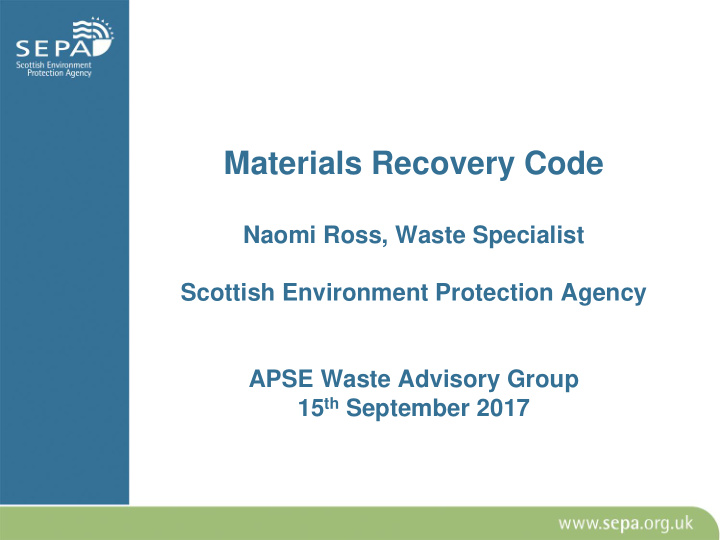



Materials Recovery Code Naomi Ross, Waste Specialist Scottish Environment Protection Agency APSE Waste Advisory Group 15 th September 2017
Overview • Materials Recovery Code Benefits • SEPA’s Approach • ‘In Scope’ Facilities • Sampling Results & Compliance • Key Audit Findings • Next Steps
Material Recovery Code Benefits • Greater transparency in the market place • More information for contractors • Stimulates market for sale & reprocessing of quality recyclate • Improves public understanding of the way their recyclable waste is managed
SEPA’s Approach – Use of Data Improve understanding of circular economy Recycling Landfill material flows legislation Tax Target Duty of Identify problem regulatory SEPA’s Care waste streams & efforts suppliers Use of Data Waste exports Improve overall Track destinations understanding of for poor quality Scottish waste materials movements
SEPA’s Approach • First site visits May-Aug 2016 • Assist with understanding of obligations • Develop SEPA staff understanding of sites • Address any SEPA sampling logistical issues • First formal compliance audits from Nov 2016 • Data specialists attending site visits • Workshop October 2016 • Data publication event June 2017 • Analysis tool & report published July 2017 • Second round compliance visits from July 2017 • Freerider work ongoing
‘In Scope’ Facilities Sampling info is based on 11 of the 13 sites. Excludes: 1. SITA UK Limited 2. Biffa Waste Services Limited, Glasgow
Sampling Results & Compliance • Caveats • Supplier Rankings • Material Inputs & Outputs • SEPA Sampling & Compliance Results • Non-Recyclables in SEPA Output Samples
Caveats • Data lifted directly from operator returns (minor amendments enable more efficient analysis) • Some waste collected under dry recyclable contracts diverted to secondary sort or residual waste facilities. So input results may not reflect true scale of contamination • Variation in facility operations & reporting terminology impact the results. E.g. • Technology & picking processes used • Type of waste accepted/targeted • Classification of materials
Supplier Rankings Clear ranking of supplier input contamination rates not currently possible from the data returns, due to the way supplier information is reported.
Material Inputs 327,760T processed since Oct 2015 from ~100 “suppliers”
Material Inputs • Avg. national input contamination rate: 16.9% (incl. non-target)
Material Outputs 237,427T recyclate extracted since Oct 2015
Material Outputs
Material Outputs – Factors Impacting Data • Target fragments lost through process • Contamination during sorting changes material from target to non-target or non-recyclable • Predominantly liquid/food from plastics/metals absorbed by paper/card • Even if clean, will change (plastic bottle is target at input, but non-target if found in output paper) • Tolerance levels with suppliers varies, sometimes impacting apparent efficiency of site (contractual fears drive this)
SEPA Sampling & Compliance Results • SEPA output sampling broadly as expected. Exceptions: • William Tracey (results for both paper & plastic more contaminated than operator reported) • William Munro (results for both paper & plastic more contaminated than operator reported, though a small margin for paper) • Saica Natur & Biffa Broxburn (one sample each more contaminated than operator reported) • All were compliant except William Tracey & Wm Munro
Non-Recyclables in SEPA Output Samples • Offensive & hazardous waste in 8 of 22 samples. Some were likely to be exported. Included: • Animal excrement • Soiled nappies & other hygiene products • Batteries & WEEE • Most common non-recyclables found: • Baby wipes • Heavily contaminated recyclables • Low grade plastic films • Crisp packets & sweet wrappers
Key Audit Findings • Recyclate Sent to Downstream Facilities • Confusion Over Identification of Recyclables • Supply Chain Engagement • Waste Exports from Materials Recovery Facilities • Duty of Care
Recyclate Sent to Downstream Facilities • Recyclables are finding their way into sorting residues. Fate seems to most frequently be RDF or landfill, with or without further sorting • SEPA will be doing more work to estimate the overall volumes & fates as well as what can be done to avoid this • A recent report by Valpak looks at recyclate losses from Scottish MRFs and reprocessors (available on their website)
Confusion Over Identification of Recyclables • Not all sampling staff understood material grades • Operator & SEPA sampling staff often struggled to identify material grades due to: • Labels being too small/faint • Labels in hard to reach places • Variation in providing information (words, symbols, numbers etc.) • Absence of recycling information • Emphasised difficulty faced by public
Supply Chain Engagement • Effective supply chain communication key to improved quality! • Tolerance variation • Sampling feedback & penalties varied • Small number of operators actively engaged with local authorities to improve households • A minority of local authorities completely disengaged • Contract variation (long term to spot sales)
Adaptation Example
Waste Exports from MRFs • Export compliance risk is evident • Average 2% non-recyclables & 7% non-target – many outputs not fit for export • +60 containers involved in repatriations, with others intercepted before export, across several of these MRFs • Use of negative picks • Failure to remove fragments • SEPA intervention so far reserved for worst scenarios where offensive/hazardous waste found
Duty of Care • Common compliance issues WRT misclassification & unknown final fate • Many operators report final destination as domestic, yet majority of material is exported • SEPA stepping up work in this area in conjunction with other UK agencies & Ireland • Mandatory e-DoC is critical
Next Steps Revisit MRFs Manufacturers Local Authorities Continue FMPs efforts to Refine Supply chain improve engagement Data material quality Duty of Care Waste exports Exempt Sites Free Riders
http://www.environment.scotland. gov.uk/get- interactive/data/recyclate-quality mrfregs@sepa.org.uk Supply chain workshop: 2 Nov
Recommend
More recommend